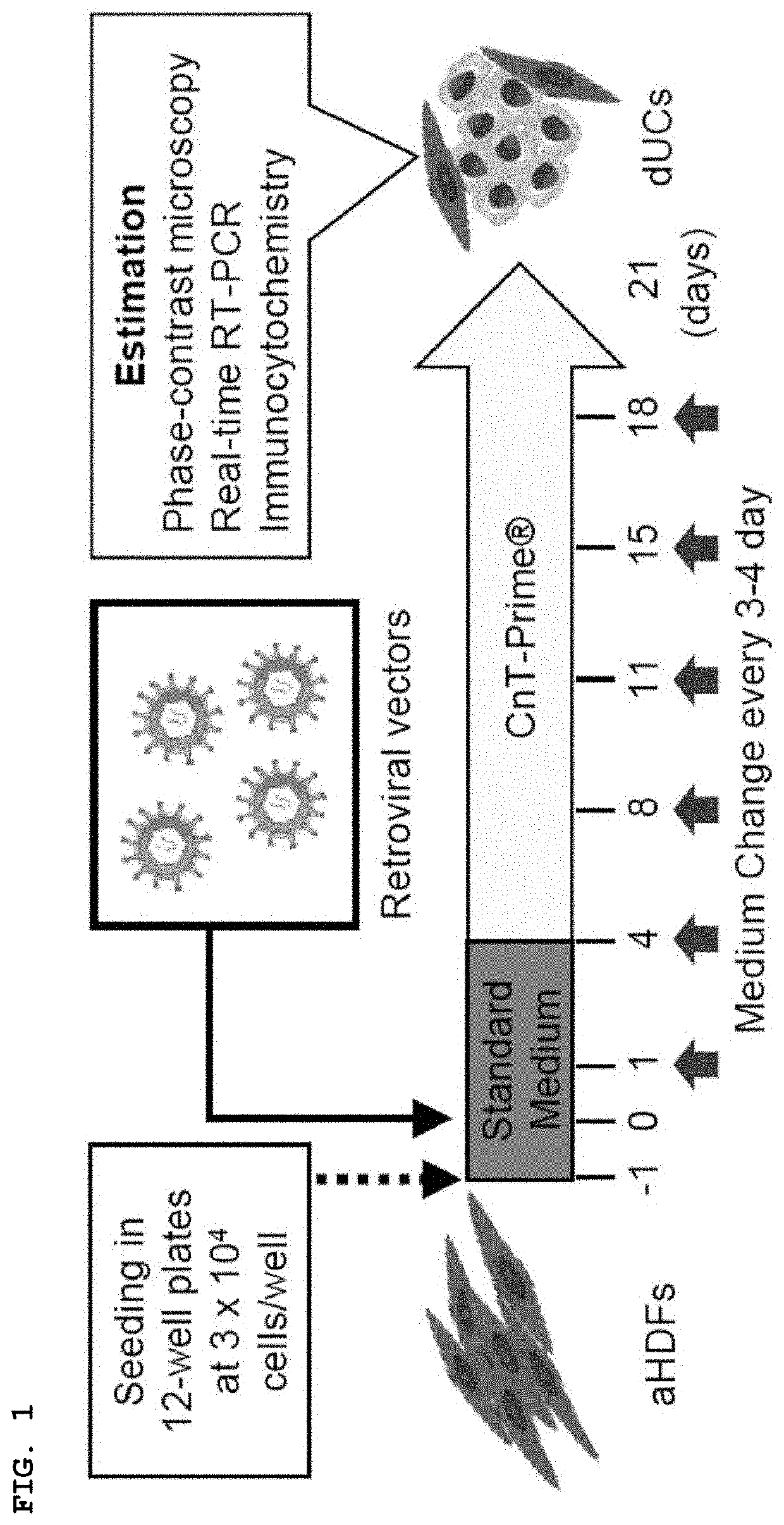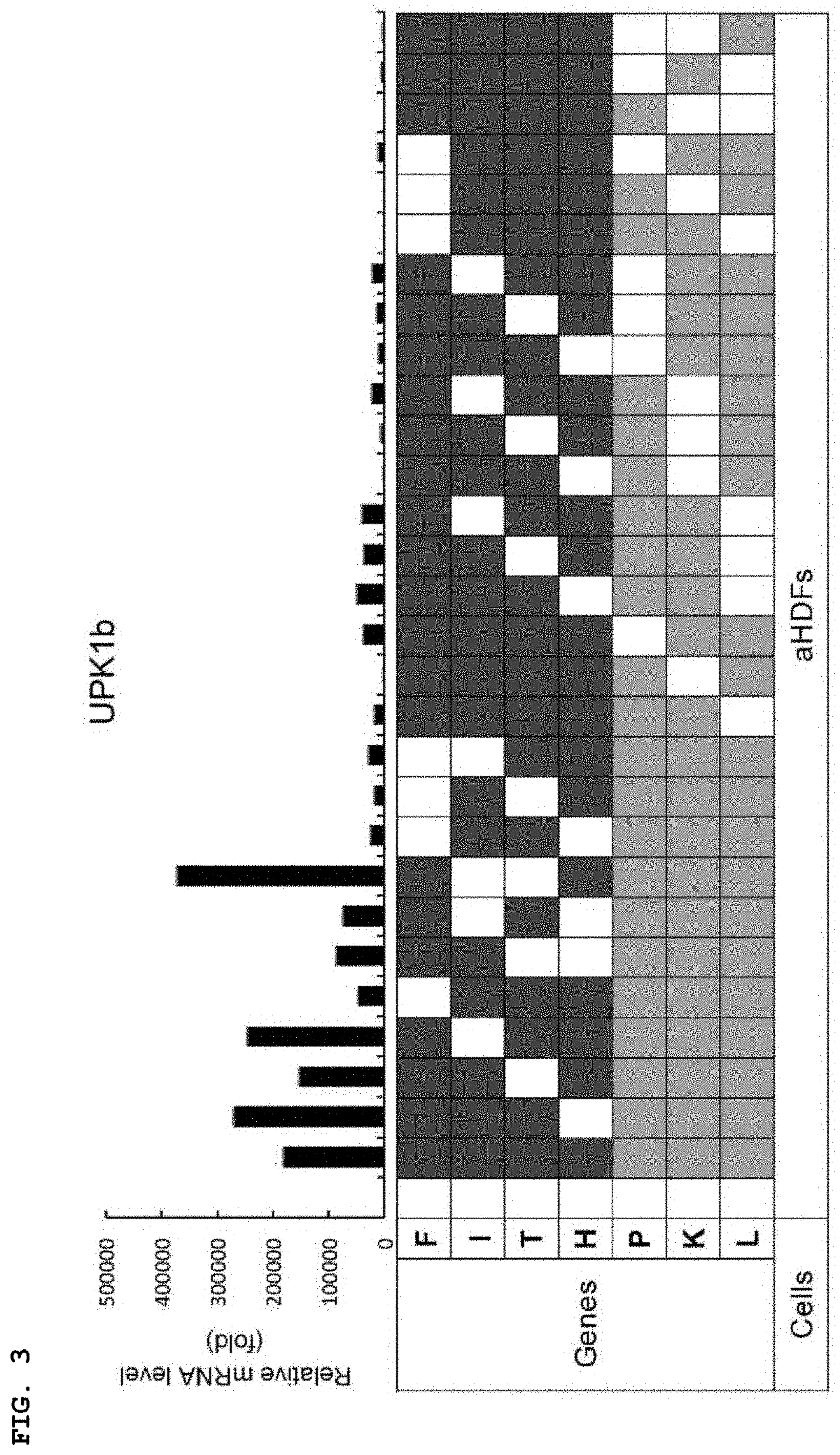Urothelial cell induction agent and method for inducing urothelial cells
a technology of urothelial cells and induction agents, which is applied in the direction of genetically modified cells, skeletal/connective tissue cells, drug compositions, etc., can solve the problems of insufficient use of methods, poor long-term results, and cancer formation
- Summary
- Abstract
- Description
- Claims
- Application Information
AI Technical Summary
Benefits of technology
Problems solved by technology
Method used
Image
Examples
example 1
[0132]Adult Human Skin Fibroblasts (aHDFs) were Induced to Express Urothelial Cell-Like Phenotype by Introducing Specific Factor.
[0133]First, three transcription factors were focused on. FOXA1(F) and IRF1(I) are important in the development of urothelial cells. On the other hand, TP63 (T) is a transcription factor that is expressed in epithelial stem cells and is associated with the development and differentiation of urothelial cells. In addition, sonic hedgehog (SHH) gene (H), which is expressed in the basement membrane cells of urothelial cells and regulates signals important for cell proliferation during the regeneration process, was added. These genes were introduced into adult human skin fibroblasts (aHDFs) using a retroviral vector and the cells were cultured in CnT-Prime medium for a period considered to be suitable for cell maintenance (21 days) (FIG. 1). In cells into which FIT or FIH was introduced, uroprakin (UPK1b), which is a development marker for urothelial cells, was...
example 2
[0137]Characteristics of Directly-Converted Urothelial Cells (dUCs).
[0138]The cells transduced by the method of Example 1 are indicated as directly-converted urothelial cells (dUC). Then, the detailed characteristics of the cells were investigated. In the time-course analysis, cells transduced by F, T, L, and K markedly expressed UPK1b 8 days after gene introduction, and the expression peaked 15 days later (FIG. 8a). The UPK2 mRNA expression began to rise after 11 days in the FTLK-transduced cells and peaked 21 days later. The formation of epithelial cell colony was observed after 11 days and increased thereafter (FIG. 8b).
[0139]In addition to the expression of UPK1b and UPK2, the expression of E-cadherin, which is a transmembrane type protein expressed in general epithelial cells, and keratin 8 / 18, which is a cytoskeleton, was confirmed. Immunocytochemical analysis revealed that about 42% of the cells expressed UPK1b, whereas 23%, 26%, and 26% of UPK2-positive, E-cadherin-positive,...
example 3
[0141]Pluripotency, Liver, Small Intestine Markers were not Expressed in dUCs.
[0142]To exclude the possibility that fibroblasts were temporarily converted to iPS cells or endodermal progenitor cells that subsequently produced urothelial cells, expression of pluripotent markers and non-urothelial endodermal markers, and the expression of non-urothelial endodermal markers in cells into which F, T, L, and K were introduced during the conversion process were examined. As a result, gene expressions of NANOG, POU5F1, LIN28, and SOX2 were not observed during the culture period in cells into which F, T, L, and K were introduced. NANOG protein was not observed, either (FIG. 10). Similarly, cells into which F, T, L, and K had been introduced did not express mRNA of small intestinal epithelial cell marker CDX2 and hepatocyte marker albumin (ALB) at any observation time (FIG. 11). In addition, cells into which F, T, L, and K had been introduced did not express mRNA of CD31, which is a mesenchym...
PUM
| Property | Measurement | Unit |
|---|---|---|
| concentration | aaaaa | aaaaa |
| concentration | aaaaa | aaaaa |
| phase contrast microscope | aaaaa | aaaaa |
Abstract
Description
Claims
Application Information
 Login to View More
Login to View More - R&D
- Intellectual Property
- Life Sciences
- Materials
- Tech Scout
- Unparalleled Data Quality
- Higher Quality Content
- 60% Fewer Hallucinations
Browse by: Latest US Patents, China's latest patents, Technical Efficacy Thesaurus, Application Domain, Technology Topic, Popular Technical Reports.
© 2025 PatSnap. All rights reserved.Legal|Privacy policy|Modern Slavery Act Transparency Statement|Sitemap|About US| Contact US: help@patsnap.com



